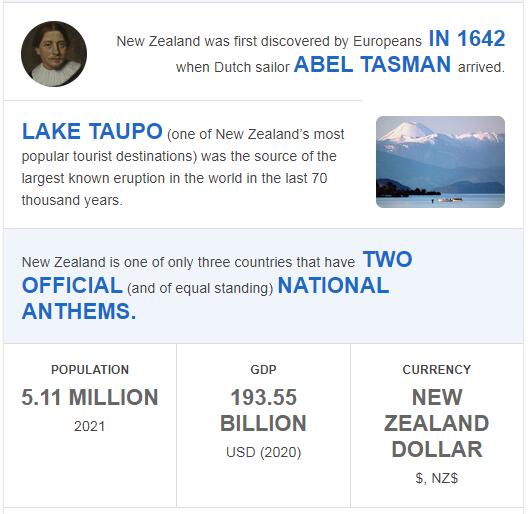New Zealand is a small country located in the South Pacific Ocean with a population of around 4.7 million people. The economy of New Zealand is largely dependent on services, tourism and agriculture with its GDP per capita estimated at US$41,708 in 2017. In terms of foreign relations, New Zealand has strong ties to other countries in the region such as Australia and Pacific Island nations as well as other countries around the world. It is also a member of the United Nations, World Trade Organization (WTO) and the Commonwealth of Nations. In terms of politics, New Zealand has a multi-party system which includes two major parties: National Party and Labour Party. The Parliament consists of 120 members who are elected by popular vote every three years. In 2017, National Party won the majority in parliamentary elections under Prime Minister Bill English’s leadership. See militarynous for New Zealand military and defense.
Yearbook 2017
New Zealand. A research group from the US Geological Society, GSA, revealed in February the discovery of a previously unknown continent, by scientists called Zeelandia. The new continent, which is New Zealand’s top, was 5 million square kilometers, which corresponds to the whole of Western Europe. However, only about 6%, mainly New Zealand and the French colony of New Caledonia, reached the surface. For over 20 years, the research team had collected data to provide sufficient evidence to be able to write about Zeelandia, the world’s eighth continent. See ABBREVIATIONFINDER for frequently used acronyms and abbreviations related to as well as country profile of New Zealand.
According to Countryaah.com, hundreds of gate whales were washed up in February in the shallow bay of Farewell Spit on the northern tip of South Island. Up to 400 of the whales died, while about as many could be rescued as the tide rose. To prevent the dead whales’ bodies from exploding with gases, rescue workers punched them with knives and long needles. Of the around nine mass beaches of gate selection that have occurred over the past ten years, this year was the worst.
In March, Parliament granted the 290-kilometer river Whanganui one-person status. The unique decision meant that the river will in future be counted as any person, for example, with the right to be represented by lawyers in a legal process. Further, the river will be seen as an indivisible unit that must not be broken up. Ever since the 1870s, the New Zealand Maoris have been fighting for the rights of the river, a struggle that, with the decision, was over.
In the wake of the cyclone Debbie, thousands of people were evacuated in the northern parts of the country in April. The severe weather, which caused extensive flooding and landslides, was described by meteorologists as something that happened about “once every five hundred years”. A week later, Debbie was followed by the cyclone Cook, which caused further flooding and power outages. The most affected were the northern and eastern parts of the country.
Labor leader Andrew Little’s dominant opposition party resigned on August 1, barely two months before the country’s parliamentary elections. The resignation came after the party’s figures dropped in the latest polls. As Little’s successor, Vice Party Leader Jacinda Ardern was elected.
The September 23 parliamentary elections resulted in the Conservative National Party getting 56 seats while Labor landed at 46. The result meant Labor increased by about 11 percentage points, which was a big success for newly-appointed Jacinda Ardern. However, neither the National Party nor Labor were given enough votes to form a government, which meant that the populist party New Zealand First (NZF) with a nine-member mandate was given a wave role.
After a long, uncertain wait, NZF leader Winston Peters announced in late October that his party had decided to support Labor in a three-party coalition with The Green Party. Thus, 37-year-old Jacinda Ardern, who just a few months earlier assumed the post of party leader in Labor, became prime minister. In the media, Ardern was described as a star shot with “rock star status”. Some of her heart issues were raising minimum wages, environmental issues and countering homelessness and child poverty.
